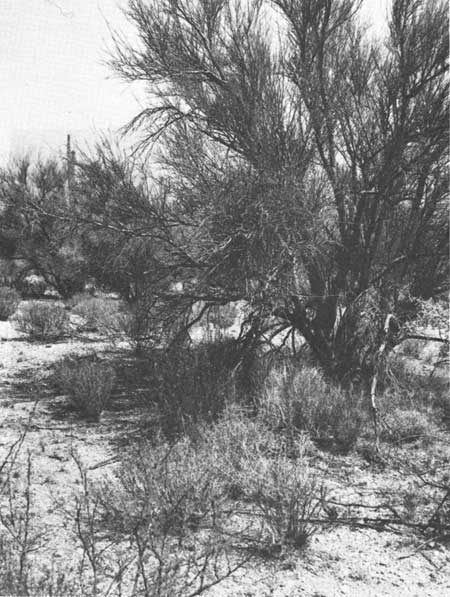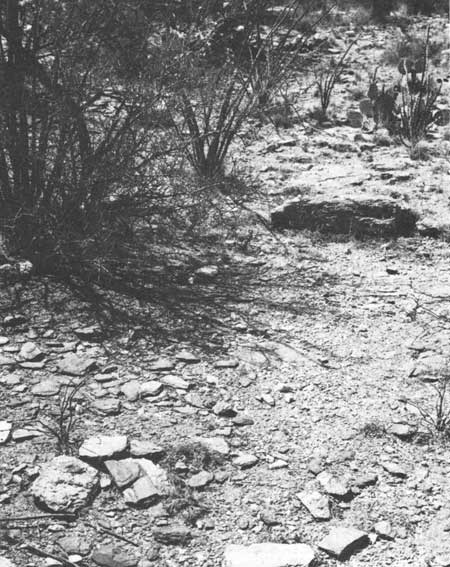|
SAGUARO
Ecology of the Saguaro: II NPS Scientific Monograph No. 8 |

|
CHAPTER 6:
OVERVIEW AND OUTLOOK (continued)
Grazing
In some portions of Saguaro National Monument, saguaro habitats have been subjected to intensive grazing by cattle for more than three-quarters of a century. In some localities, particularly the Cactus Forest area of the east monument, this has had an unquestionably detrimental effect on the germination, establishment, and survival of young saguaros (Figs. 47-50).
Direct destruction of young saguaros has resulted from the long-continued trampling of cattle seeking shade and forage beneath the crowns of desert trees, mainly paloverde and mesquite (Figs. 47A, 50A). This degradation of microenvironments favorable to saguaro establishment and survival continued for a period of many decades and has resulted in a correspondingly reduced density of saguaros surviving from the year-classes of that period.
An even more significant effect of cattle grazing has been the impact of continued grazing pressure upon the physical structure of the plant community (Figs. 47-50). The resulting deterioration of the natural multistoried tree and shrub cover and the modification of associated microenvironments seriously reduced the number and quality of sites available for the germination, establishment, and survival of young saguaros.
Livestock grazing has had its greatest impact in nonrocky habitats where the germination, establishment, and survival of young saguaros are most directly dependent upon the physical protection of other vegetation (Figs. 47A, 48A, and 50A). In these habitats a multistoried canopy of overhanging tree branches together with shrubs provides concealment from destructive animals and effectively moderates extremes of drought and subfreezing temperatures (Fig. 50B).

|
| Fig. 47A. Actively grazed paloverde-saguaro (Cercidium microphyllum-Cereus giganteus) community adjacent to Saguaro National Monument (east). Note the sparsity of shrubs and grasses. Beneath the trees, fallen limbs that would offer protection for young saguaros have been pulverized by trampling cattle. Photographed 7 August 1969. |

|
| Fig. 47B. Paloverde-saguaro (Cercidium microphyllum-Cereus giganteus) community after 11 years' protection from cattle grazing. Compare with adjacent site shown in Fig. 47A. The multistoried canopy of shrubs and overhanging tree branches provides young saguaros with concealment from destructive animals and effectively moderates extremes of drought and subfreezing temperatures. Young saguaros now commonly occur in such regenerated microenvironments. Photographed 7 August 1969. |

|
| Fig. 48A. Closely cropped desert zinnia (Zinnia pumila, a low desert shrub), and desert fluffgrass (Tridens pulchellus) at the actively grazed site shown in Fig. 47A. Fountain pen (center) provides scale. Compare with Fig. 48B. Not only grasses, but many species of shrubs and even portions of some trees (flowers, leaves, and succulent new branches) are heavily utilized by desert cattle. Photographed 7 August 1969. |

|
| Fig. 48B. Natural regeneration of desert zinnia (Zinnia pumila) and fluffgrass (Tridens pulchellus) at Saguaro National Monument (east); same site as Fig. 48A. Fountain pen (center) provides scale. In this environment, young saguaros are commonly found under trees growing in close assoication with such "nurse-plant" shrubs. Photographed 7 August 1969. |

|
| Fig. 49A. Intensively grazed rocky footslope of the Rincon Mountains, Saguaro National Monument (east). Sparse ground cover greatly increases the severity of heat, cold, and drought. Perennial vegetation includes foothill paloverde (Cericdium microphyllum), ocotillo (Fouquieria splendens), sangre-de-drago (Jatropha cardiophylla), and pricklypear cactus (Opuntia englemanni). Photographed 22 May 1969. |

|
| Fig. 49B. Natural regeneration of vegetation on rocky footslopes exclusion of cattle in Saguaro National Monument; same immediate locality as Fig. 49A. Eleven years' protection from livestock grazing has resulted in the development of extensive grass cover: side oats grama (Bouteloua curtipendula), slender grama (Bouteloua filiformis), bushmuhly (Muhlenbergia porteri), and Arizona cottontop (Trichachne californica). Photographed 22 May 1969. |

|
| Fig. 50A. The area surrounding this mesquite tree (Prosopis juliflora) at Organ Pipe Cactus National Monument has been denuded by grazing and shade-seeking cattle. Consumption and trampling by cattle has eliminated nearly every living plant at this intensively used site. Continued use precludes establishment of new plants. Photographed 8 December 1969. |

|
| Fig. 50B. A short distance from the site in Fig. 50A there are seven juvenile saguaros growing among the cast limbs beneath the dense crown of this foothill paloverde tree (Cercidium microphyllum). Cattle have avoided this site which produces little or no forage and is protected by low, overhanging tree limbs. Photographed 8 December 1969. |
In rocky habitats, livestock grazing has had far less impact upon young saguaros. There, as in nonrocky habitats, the protective cover of associated vegetation contributes to the germination, establishment, and survival of young saguaros. However, the deteriorating effect of livestock grazing in these habitats decreases in importance as the fate of young saguaros becomes increasingly related to their association with protective rock outcrops. Thus, despite the seriously destructive effect of grazing upon the other vegetation in these habitats (Fig. 49A), the age-class structure and the density of young saguaros in these populations have been affected much less by livestock grazing than those in nonrocky habitats.
In summary, the primary role of historic livestock grazing has been to reduce the density of affected saguaro populations by decreasing the number of sites suitable for germination and establishment of young plants by increasing exposure to natural mortality-causing factors. Differential impact, i.e., differential mortality, has been associated with differences in the intensity and duration of grazing and the physical characteristics (rockiness) of the terrain. Mortality is highest in intensively grazed, relatively flat, nonrocky terrain, and lowest in less intensively grazed, steep slopes with extensive rock outcrops. Natural regeneration of vegetation is occurring (Figs. 47B, 48B, and 49B) and natural rates of germination, establishment, and survival of young plants are now occurring in habitats under National Park Service protection that were heavily grazed earlier in the century.
| <<< Previous | <<< Contents >>> | Next >>> |
chap6a.htm
Last Updated: 21-Oct-2005